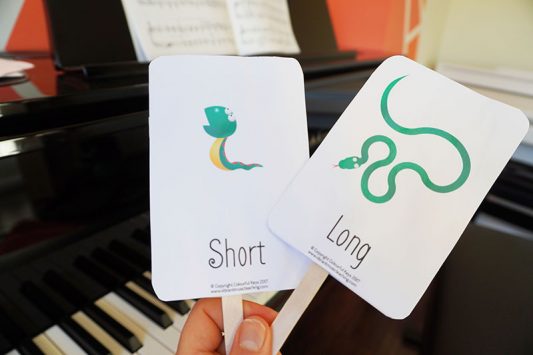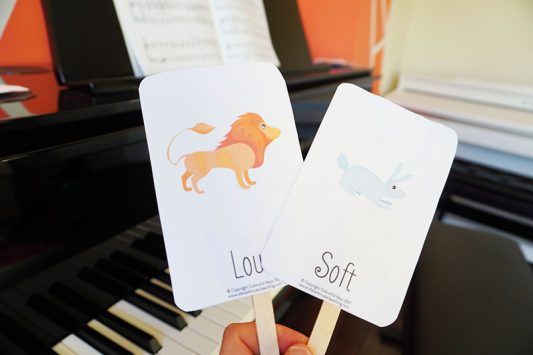Aural skills games for piano beginners shouldn’t feel like some kind of test, even when we do need to check in on their ear training progress. These ‘voting paddles’ make ear training so much fun – just don’t tell students you’re actually testing them. (That can be our little secret🤫…)

The content in this article was originally published in March and June 2014, then expanded and updated in March 2021.
There are lots of reasons why I like to use these voting paddles for ear training activities:
- They pull double-duty, being useful both for aural tests and for ear training
- Combining a physical action (such as waving paddles) with the listening exercise makes learning stickier
- The picture versions make the paddles suitable even for preschoolers who can’t read, while the notation versions reinforce terms and symbols
- It’s easy to sneak in snippets of other learning at the same time, such as exploring the piano and using peripheral vision while playing
The First 4 Aural Skills for Beginners
The first 4 aural elements I like to focus on with beginners are same/different, high/low, long/short and loud/soft. Let’s unpack each of these.
Same and Different
The first listening element I introduce to beginner piano students is same vs. different. Usually this is in the first or second lesson, when we’re just starting to explore the piano together.
First we simply look at the paddles together. Depending on the age of the student, same and different may not be a concrete concept to them yet – so with preschoolers, I start with the pictorial paddles by talking about how the 2 orange slices are the same but the orange slice and the strawberry are different.

Then, we relate this information to the piano, playing the same note twice, and then two different notes. Next the student gets the two paddles, one for each hand. As I play notes, they need to hold up the corresponding paddle.
We usually start off with them facing the piano, so they can see the keys I’m playing, and then we turn their chair around so they need to rely on their ears.
Lastly, we swap roles – as I hold up a paddle, they need to play their own example of same notes or different notes. This reinforces the concept and gets them to explore the piano.
For the littlest of the little kiddos, I encourage them to hold the paddle high in the air up above their head just because it makes us giggle…and if they need to get the wiggles out, I have them jump up and down while waving the paddle!
High and Low
The next ear training element I discuss with piano beginners is high sounds vs low sounds. We repeat the same process with the voting paddles, usually in lesson two or three.
First they hold the paddles, I play notes, and they need to hold up the correct sign – high in the sky like a bird, or low deep down in the sea like a fish.

We then do the same test “blind”, and then swap roles again. When they are playing the notes themselves I encourage them to use their right hand to play the high notes and their left hand for the low notes.
Long and Short & Soft and Loud
I normally discuss these two ideas in the same lesson, around week 3 or 4. Using same method as before, we first talk together about the concepts and how the animals reflect them. Then we do the voting at sight, followed by ear tests.

When it’s time for them to play and me to hold up the signs, we either start at the bottom or top of the piano, using the right or left hand as appropriate, and work our way towards the middle.
I hold up one of the signs, and then change them every few notes at random. They need to adapt their playing as quickly as they can.

This not only teaches long sounds vs. short sounds and soft sounds vs. loud sounds, but it also starts to introduce them to using their peripheral vision to play the piano whilst keeping their eye on the paddles.
This is a great additional benefit of this exercise. Although some kids get this instinctively when they start to read music, others can really struggle with it, so I use every opportunity to introduce it early.
Psst….When teaching newbies the difference between forte and piano, you might also like this worksheet.
Make Your Own
Download your own aural training paddles below or, if you’re a member of our teachers’ membership program Vibrant Music Teaching, you can access the file instantly in the VMT Library.

Subscribe to the newsletter and get the Aural Training Paddles.
Enter your details to subscribe to the newsletter for piano teachers with information, tips and offers.
I hate spam as much as you do! I will only send you emails related directly to piano teaching and you can unsubscribe at any time.
I printed 2 copies of each, laminated them separately and then glued them together, sandwiching a popsicle stick in between to create my paddles.
Variations on using the aural voting paddles
For slightly older students or those already learning terms and symbols, you could use the treble and bass clef voting paddles instead of the bird and the fish (for example) or the forte and piano paddles instead of the lion and bunny.

These aural skills games for piano beginners are even adaptable for online lessons. You could have your student jump up high or crouch down low instead of waving the fish or bird aural paddle. When it’s time for the blind voting, simply turn your camera off so they can’t see what keys you play. You can hold the paddles up on your end when it’s time for them to play.
Ear Training Element #5
Once your beginner student is fairly comfortable with same/different, high/low, loud/soft and long/short, it’s time to introduce up/down/same.
One way to practice this listening skill is with a very simple worksheet. I play 2 notes – one after the other – and the student circles the correct symbol.
I kept this worksheet straightforward, so I could easily adapt it to each student. And if you laminate the page, students can use the same worksheet over and over with dry erase markers.
To make it easier:
- Make the intervals bigger
- Play slowly
- Talk through what you are playing (“Now here’s the second note,” for example)
- Let them watch!
To make it more challenging:
- Use smaller intervals
- Play quickly or use staccato notes
- Don’t speak at all until the worksheet is complete
- Play very high or very low notes (as these are generally more difficult for people to hear clearly)
If you need ideas for ear training past the beginner level, head over to the Ear Training section of my Music Theory page for the latest and greatest.
What are your favourite aural skills games for piano beginners?
Do you use aural voting paddles like these, or do you have another go-to exercise? Share your beginner ear training activities in the comments below or in the Vibrant Music Studio Teachers Facebook Group.


This was part of a free series of 9 games in July 2019. I am already subscribed to the newsletter. How do I get access to this please?
You just enter your details in the box above, Rachel. There’s no such thing as subscribing twice. 🙂
Tahnk you
This looks a great concept to teach and enjoyable and fun for my students.